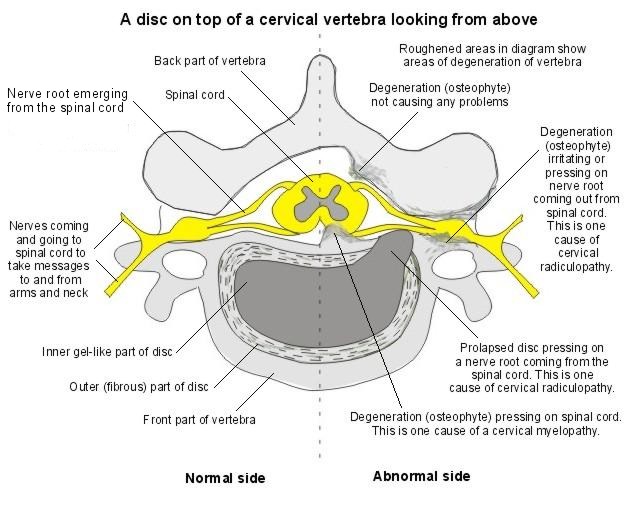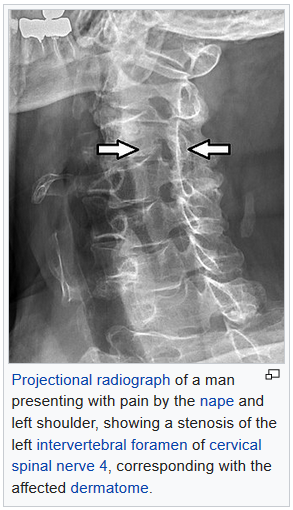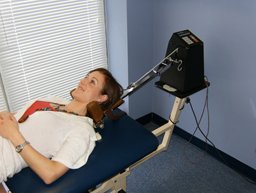nalco group
bone, muscle & joint pain physio
BOOK NOW / WHATSAPP ABOUT YOUR PAIN OR INJURY
- NOVENA 10 Sinaran Drive, Novena Medical Center #10-09, Singapore 307506
- TAMPINES 9 Tampines Grande #01-20 Singapore 528735
- SERANGOON 265 Serangoon Central Drive #04-269 Singapore 550265
Home > Blog > Physiotherapy > Spinal Physiotherapy > Conditions > Neck Pain > Cervical Radiculopathy Physiotherapy
Cervical Radiculopathy Physiotherapy

Cervical radiculopathy is often referred to as a pinched nerve in the neck.
It is primarily characterized by radiating pain from the neck to the
- shoulder
- shoulder blade
- arm or
- hand
Weakness and lack of coordination in the arm and hand can also occur.
The condition affects an average of 85 out of 100,000 people—most often in patients who are 50 years old and above. Individuals who are more at risk are:
- Athletes, heavy laborers, and workers who use vibrating machinery
- People who sit for long periods of time
- Individuals with arthritis in the cervical (neck) region can also be affected
Our senior physiotherapists can help bring pain relief to the acute neck and arm symptoms that result from the condition, as well as improve general strength and function. Most cases of cervical radiculopathy are resolved with spinal physiotherapy (including computerized decompressive spinal traction therapy) and do not require surgery.
What is Cervical Radiculopathy?
Cervical radiculopathy occurs when a nerve root coming off the spinal cord becomes compressed.
This compression can happy for many reasons.
- In younger people, it may occur when a cervical disc herniates due to
trauma such as in sports injuries, falls or accidents
- In older individuals, it commonly occurs spontaneously as a
result of arthritis or decreased disc height in the neck region (such as in degenerative disc disorder)
Our cervical (neck) spine is made of 7 cervical vertebrae (the bones that form the neck region) and each spinal vertebra is separated by a gel-like disc. What this spinal discs do is they provide shock absorption for the spine.
The spinal cord travels through a canal in the cervical vertebrae and spinal nerve roots extend from the spinal cord and branch off going to specific locations in the arm.
The spinal nerves send signals to our muscles for movement as well as sensations that we feel in the entire arm. The spinal cord is like a tree trunk, and the spinal nerves are like the tree branches.
If an impingement or abnormal pressure is placed on a branch near the trunk, everything along that branch will be affected.
Our spinal nerves can be impinged by:
- Arthritis or disc wear-and-tear with age
- Herniated / slipped discs or bulging discs from trauma or degeneration
- Spinal stenosis, which is a narrowing of the spaces in which the nerves travel
- Tumor, which can be benign or malignant, impinging the nerve root
When the spinal nerves are impinged, they cannot properly send or transmit messages to the muscles from the brain, nor receive proper sensation from the specific arm location the nerve travels.
Everywhere the spinal nerve travels will be affected.
And that's why a compressed or pinched nerve in the neck can cause
- pain
- weakness
- and altered or loss of sensation in the arm
even though the pinch is in the cervical region.
How Does cervical radiculopathy Feel like?
Symptoms of cervical radiculopathy is different and varies depending on the nerve root of the cervical that is involved/compressed, and usually it happens on the same side of the body as the affected nerve.
Cervical radiculopathy symptoms may include:
- Neck pain, shoulder blade pain, shoulder pain, upper chest pain, arm pain, with pain possibly radiating into the fingers following the path of the involved nerve root.
- Pain described as "sharp" or "pins-and-needles" or “popping sensation” in cervical region.
- General dull ache or numbness anywhere along the pathway of the nerve.
- Weakness in the shoulder, arm, or hand.
- Pain that worsens with certain neck movements.
- Pain that improves when the arm is lifted over and behind the head (relieving tension on the spinal nerve).
These symptoms may also be specific to the nerve root involved:
- C5 nerve root (between cervical vertebrae C4-C5): weakness in the deltoid muscle (front and side of the shoulder) and upper arm; shoulder pain and numbness
- C6 nerve root (between cervical vertebrae C5-C6): weakness in the bicep muscle (front of the upper arm) and wrist muscles; numbness on the thumb side of the hand
- C7 nerve root (between cervical vertebrae C6-C7): weakness in the triceps muscle (the back of the upper arm and wrist); numbness and tingling in the back of the arm and the middle finger of the affected hand
- C8 nerve root (between vertebrae C7-T1): weakness with hand grip; numbness in the little finger
The most common nerve root levels for this condition are C6 and C7.
How Is cervical radiculopathy Diagnosed?

When you seek the help of our senior physiotherapist,they will perform an in-depth comprehensive evaluation and asks questions about your pain and your daily activities.
These may include:
- How and when the pain started: Did the pain begin spontaneously or was there any trauma or popping experienced in the cervical region?
- Where are the symptoms located, and have they changed location or intensity since the onset?
- What makes the symptoms better or worse?
- What type of work do you perform?
- What hobbies or household activities do you regularly perform?
They will gently test the movement of your neck and arms as well as check your tendon reflexes and strength, and conduct special tests on your neck and upper extremity to determine which spinal nerve root(s) may be involved, and to rule out other conditions.
To provide a definitive diagnosis, our senior physiotherapist may collaborate with our medical network of doctors who may order further tests, such as
- magnetic resonance imaging
(MRI) or
- electromyography (EMG)
An MRI can show soft tissues, including the spinal cord and nerve roots. This test can determine what is causing the compression on the nerves, including disc bulges or any spinal disc herniation. An EMG measures the nerve and muscle function. This test can tell how well your spinal nerves are communicating to your muscles.
How Can our senior PhysioTherapists Help?
Physiotherapy is an effective treatment for cervical radiculopathy, and in many cases, it completely resolves your pains and symptoms. We will develop an individual treatment plan based on the findings of your initial evaluation.
Cervical radiculopathy physiotherapy treatment plan may include:
Pain Management. The first goal is to reduce the pain and inflammation in the area. Cold therapy applied to the neck and scapular (shoulder blade) region during the first 24 to 48 hours following the onset of pain to help reduce inflammation. Moist heat can be used after this time period to help the surrounding muscles relax. We may advise you to wear a soft cervical collar at times throughout the day, to allow the neck to relax. A cervical contoured pillow may be recommended to properly support the neck, and allow you to sleep more comfortably.

Manual Therapy. We may use manual therapy techniques, such as manual cervical traction (or computerized decompression spinal traction), to relieve pressure in the cervical (neck) region. This procedure can provide immediate relief of pain and numbness radiating into the arm. Gentle massage may also be performed on the muscles of the cervical spine and scapular (shoulder blade) region. This technique helps the muscles relax and improves circulation to the area, promoting healing and pain relief.
Posture Education. Posture education is an important part of rehabilitation. We may suggest ergonomic adjustments to your workstation and work habits, to promote good posture to protect your neck. In the early stages of recovery this may mean sitting only 15 to 20 minutes at a time. You will also receive instructions on how to bend, reach, and lift throughout the day in safe positions that place minimal pressure on your spinal discs.
Range-of-Motion Exercises. We will teach you gentle cervical mobility exercises to relieve your symptoms, and allow you to return to normal movement. In the beginning stages of recovery, it is important that none of these exercises increase the pain radiating down into your arm. It is important to communicate your symptoms accurately to our senior physiotherapists. If you spend many hours sitting at a desk during your workday, your neck may become stiff. We will teach you neck stretches to take pressure off of your neck from extended periods of sitting, to help improve your mobility.
Strengthening Exercises. We
will help you determine which muscle groups need to be strengthened
based on which spinal nerves are involved in your particular case. When
pain no longer radiates down your arm, you may begin more aggressive
strengthening exercises. Neck stability (strengthening) exercises will
also be performed.
